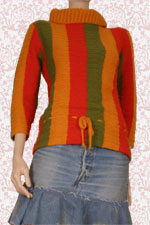
Types and design
The term "sweater" is a catch-all for various types of garments. A fundamental division is between a cardigan (which opens in front) and a pullover (which does not). If the sweater has no sleeves, it is generally called a vest.
Even within these groups, there is a great variety of design. All the various types of necklines are found, although the V-neck, turtleneck and the crew neck are the most popular. The waistline is typically at hip height, but can vary significantly. The sleeve length is likewise variable, ranging from small cap sleeves to short sleeves to three-quarter sleeves to full-length sleeves. The front seam of a cardigan allows for further possibilities, such as a surplice or a bolero jacket. All the hems may have various types of borders, such as picots, ribbing (knitting) and frills.
One advantage of sweaters is that they conform well to the body without requiring the tailoring as woven garments. For example, shaping such as darts, flares and gores — commonly found in woven blouses, a comparable garment — are rarely needed in sweaters, thanks to the Elasticity and drape of knitted fabrics. Even when such shaping is needed, it can be knit into the fabric itself, without requiring seams. However, this very elasticity makes it necessary to use more care when washing.
If made of thick cotton, it is usually known as a sweatshirt. A hooded sweatshirt is commonly known as a hoodie. These items of clothing have been vilified in the United Kingdom as representative of a yob culture and banned from a number of shops and shopping centres.[1] However hoodies showing affliation to subjects, groups, colleges (in the case of collegiate universities) and universities themselves are common wear from students in further education. A jumper with an open front fastened by buttons or a zipper, is called a cardigan. A hockey sweater was, in the early days of ice hockey, recognisable as what people in the 2000s would call a sweater, but has since evolved into a sort of jersey. Thus, in modern-day North American usage, the shirt of an ice-hockey player's uniform is traditionally called a sweater, regardless of the style.
In British English, a sweater is called a pullover, sweater, jersey, or jumper, this last term being the most common name in British English and Australian English. In South African English, a sweater is always called a jersey. Sleeveless pullovers are known in American English and Australian English as vests or sweater vests. In British English they are known as tank tops.


Customary wear
Thin sweaters may be worn tucked in to the waistband of trousers; but otherwise, men's sweaters are to be worn untucked.
Sweaters are a versatile item of clothing, which can be worn on top of almost any outfit. Sports sweaters, especially hoodies, are often worn on tops of sports kit which travelling to or from a sports ground. As a part of the preppy style sweaters are worn with a dress shirt underneath (and optionally a tie), which has the advantage of allowing the wearer to have the option of removing the sweater when it is uncomfortably warm and still look presentable in many situations with only the shirt. In the late 20th century the sweater increasingly came to be worn as an alternative to a shirt when finer materials made them more comfortable next to the skin.
Some women's sweaters are meant to be worn belted; sometimes, a belt or drawstring is knitted into the sweater itself.
In ice hockey, the uniforms that present day players wear are sometimes referred to as "sweaters" although they more resemble the jerseys worn in other sports. This is because original uniforms were simply sweaters with the team's logo stiched on the front. However, as technology changed, so did the uniforms as actual sweaters absorbed too much moisture and became weighed down and bulky throughout the course of a game.


No comments:
Post a Comment